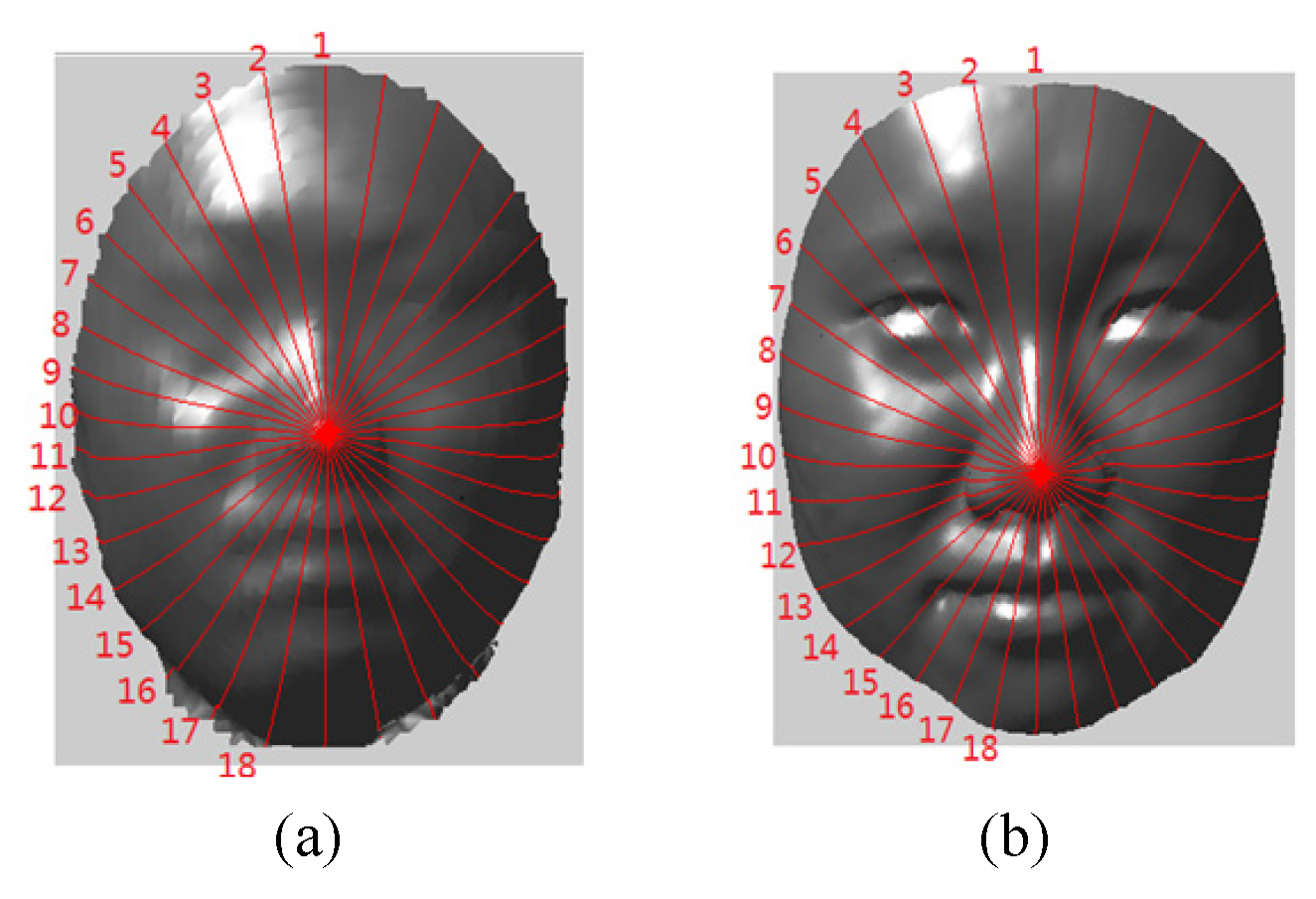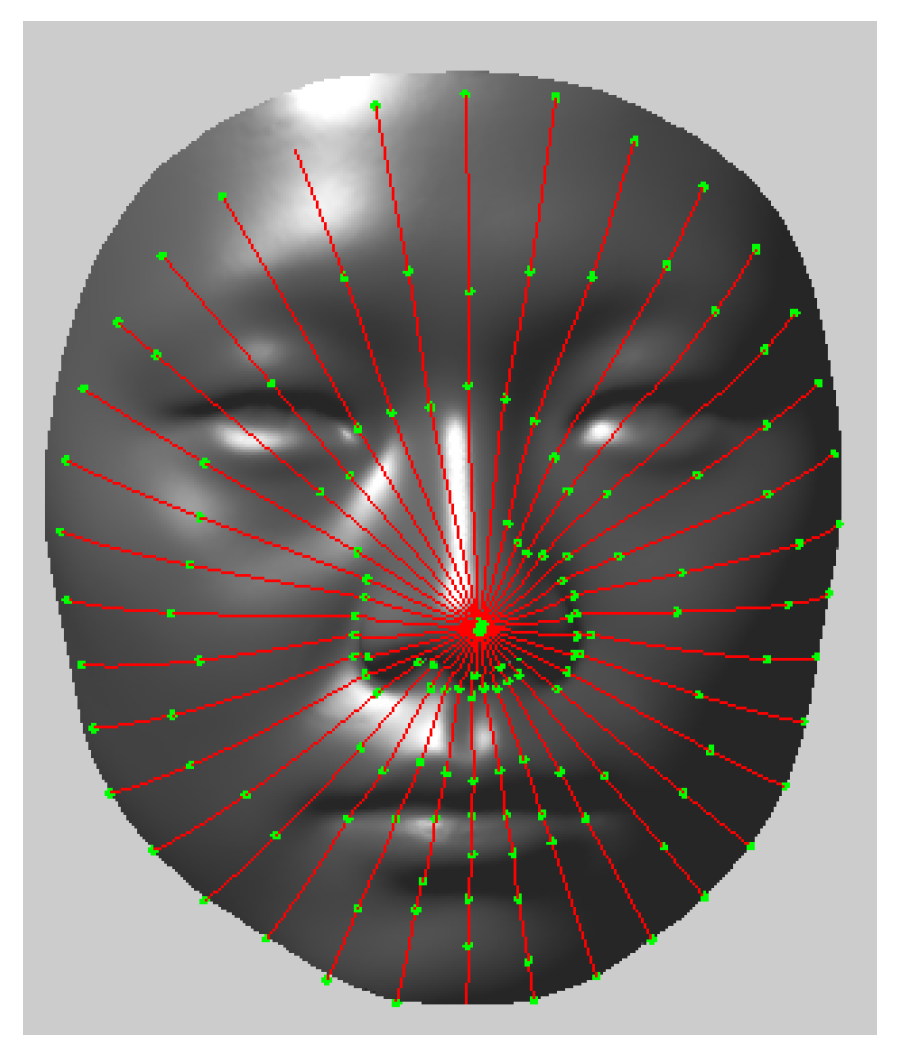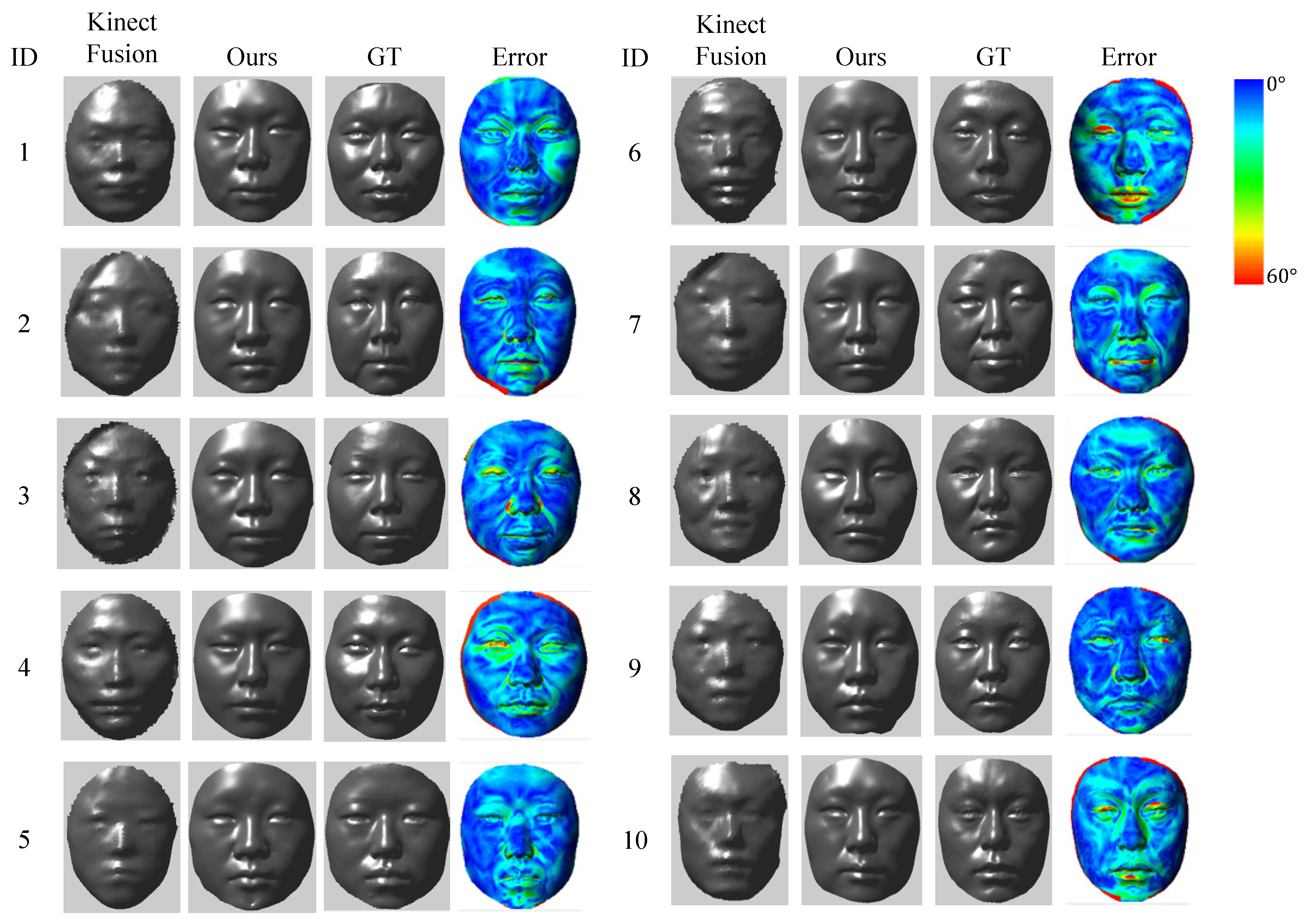3D Face Model Super-Resolution Based on Radial Curve Estimation
Abstract
:1. Introduction
2. Related Work
3. Method
3.1. The Radial Curves’ Extraction
3.2. Radial Curves Database
3.3. Face Model Super-Resolution
3.3.1. Registration of Radial Curves
3.3.2. Radial Curve Estimation
3.3.3. High Resolution Face Model Estimation
4. Experiment
4.1. Experiment Setting
4.1.1. Dataset
4.1.2. Error Metric
4.2. Results and Analysis
4.3. Discussion
5. Conclusions
Author Contributions
Funding
Conflicts of Interest
References
- Berretti, S.; Del Bimbo, A.; Pala, P. Superfaces: A super-resolution model for 3D faces. In Proceedings of the European Conference on Computer Vision, Florence, Italy, 7–13 October 2012; pp. 73–82. [Google Scholar]
- Newcombe, R.A.; Izadi, S.; Hilliges, O.; Molyneaux, D.; Kim, D.; Davison, A.J.; Kohli, P.; Shotton, J.; Hodges, S.; Fitzgibbon, A.W. Kinectfusion: Real-time dense surface mapping and tracking. In Proceedings of the 2011 10th IEEE International Symposium on Mixed and Augmented Reality, Basel, Switzerland, 26–29 October 2011; Volume 11, pp. 127–136. [Google Scholar]
- Drira, H.; Amor, B.B.; Daoudi, M.; Srivastava, A. Pose and expression-invariant 3d face recognition using elastic radial curves. In Proceedings of the British Machine Vision Conference, Aberystwyth, UK, 31 August–3 September 2010; pp. 1–11. [Google Scholar]
- Nasrollahi, K.; Moeslund, T.B. Super-resolution: A comprehensive survey. Mach. Vis. Appl. 2014, 25, 1423–1468. [Google Scholar] [CrossRef] [Green Version]
- Schuon, S.; Theobalt, C.; Davis, J.; Thrun, S. Lidarboost: Depth superresolution for tof 3d shape scanning. In Proceedings of the 2009 IEEE Conference on Computer Vision and Pattern Recognition, Miami, FL, USA, 20–25 June 2009; pp. 343–350. [Google Scholar]
- Berretti, S.; Pala, P.; Del Bimbo, A. Face recognition by super-resolved 3D models from consumer depth cameras. IEEE Trans. Inf. Forensics Secur. 2014, 9, 1436–1449. [Google Scholar] [CrossRef]
- Hernandez, M.; Choi, J.; Medioni, G. Laser scan quality 3-d face modeling using a low-cost depth camera. In Proceedings of the 2012 Proceedings of the 20th European Signal Processing Conference (EUSIPCO), Bucharest, Romania, 27–31 August 2012; pp. 1995–1999. [Google Scholar]
- Bondi, E.; Pala, P.; Berretti, S.; Del Bimbo, A. Reconstructing high-resolution face models from kinect depth sequences. IEEE Trans. Inf. Forensics Secur. 2016, 11, 2843–2853. [Google Scholar] [CrossRef]
- Pan, G.; Han, S.; Wu, Z.; Wang, Y. Super-resolution of 3d face. In Proceedings of the European Conference on Computer Vision, Graz, Austria, 7–13 May 2006; pp. 389–401. [Google Scholar]
- Peng, S.; Pan, G.; Wu, Z. Learning-based super-resolution of 3D face model. In Proceedings of the IEEE International Conference on Image Processing, Genoa, Italy, 1–14 September 2005; Volume 2, p. II-382. [Google Scholar]
- Liang, S.; Kemelmacher-Shlizerman, I.; Shapiro, L.G. 3d face hallucination from a single depth frame. In Proceedings of the 2014 2nd International Conference on 3D Vision, Tokyo, Japan, 8–11 December 2014; Volume 1, pp. 31–38. [Google Scholar]
- Cui, Y.; Schuon, S.; Thrun, S.; Stricker, D.; Theobalt, C. Algorithms for 3d shape scanning with a depth camera. IEEE Trans. Pattern Anal. Mach. Intell. 2012, 35, 1039–1050. [Google Scholar]
- Chen, Y.; Zhao, J.; Deng, Q.; Duan, F. 3D craniofacial registration using thin-plate spline transform and cylindrical surface projection. PLoS ONE 2017, 12, e0185567. [Google Scholar] [CrossRef] [PubMed] [Green Version]
- Wang, Y.; Liu, J.; Tang, X. Robust 3D face recognition by local shape difference boosting. IEEE Trans. Pattern Anal. Mach. Intell. 2010, 32, 1858–1870. [Google Scholar] [CrossRef] [PubMed] [Green Version]
- Zhao, J.; Itti, L. Shapedtw: Shape dynamic time warping. Pattern Recognit. 2018, 74, 171–184. [Google Scholar] [CrossRef] [Green Version]
- Roy, M.; Foufou, S.; Truchetet, F. Mesh comparison using attribute deviation metric. Int. J. Image Graph. 2004, 4, 127–140. [Google Scholar] [CrossRef]
- Fouhey, D.F.; Gupta, A.; Hebert, M. Data-driven 3D primitives for single image understanding. In Proceedings of the IEEE International Conference on Computer Vision, Sydney, Australia, 1–8 December 2013; pp. 3392–3399. [Google Scholar]






© 2020 by the authors. Licensee MDPI, Basel, Switzerland. This article is an open access article distributed under the terms and conditions of the Creative Commons Attribution (CC BY) license (http://creativecommons.org/licenses/by/4.0/).
Share and Cite
Zhang, F.; Zhao, J.; Wang, L.; Duan, F. 3D Face Model Super-Resolution Based on Radial Curve Estimation. Appl. Sci. 2020, 10, 1047. https://doi.org/10.3390/app10031047
Zhang F, Zhao J, Wang L, Duan F. 3D Face Model Super-Resolution Based on Radial Curve Estimation. Applied Sciences. 2020; 10(3):1047. https://doi.org/10.3390/app10031047
Chicago/Turabian StyleZhang, Fan, Junli Zhao, Liang Wang, and Fuqing Duan. 2020. "3D Face Model Super-Resolution Based on Radial Curve Estimation" Applied Sciences 10, no. 3: 1047. https://doi.org/10.3390/app10031047
APA StyleZhang, F., Zhao, J., Wang, L., & Duan, F. (2020). 3D Face Model Super-Resolution Based on Radial Curve Estimation. Applied Sciences, 10(3), 1047. https://doi.org/10.3390/app10031047




